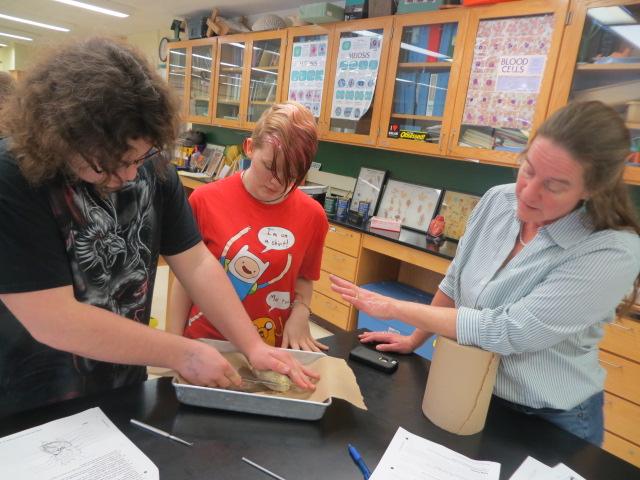Weedsport Students Take Dissection to Heart
WHS students Drake Butler and Kara Donnelly work on a dissection while Mrs. Holden advises.
January 6, 2015
The dissection unit is so important in Biology classes that it has become borderline stereotypical. At some point in any student’s education they will have to dissect an organ or animal while taking a science class. In Weedsport this begins in seventh grade by dissecting a frog and then lays dormant in the curriculum until tenth grade in the Living Environment course. This includes dissecting organs, the most memorable being the cow’s heart, which can be both an exciting prospect, or the source of much discomfort.
The issue with the dissections for some students, is that they do not want to participate in the procedure for various reasons. Be it a more social issue such as a religious reason, or that the student is vegitarian, to the simple fact that some people are more squeamish than others and would be grossed out by interacting with the organs and animals.
I have recently spoken with the Living Environment instructor, Mr. John Lawler on the issue of dissection. I asked him why he thought that dissections were important to education. He responded by saying that the opportunity to see the organs firsthand is a very rare thing, and that missing out on it could be something to regret later on. He stressed the importance of knowing about the human body, not only for those who would want a career in medicine, but for an individual to help them understand more about their own personal health. This is especially important considering heart related problems are the number one cause of death of any medical condition here in the U.S. due to our diets.
When faced with the more cautious student, Mr. Lawler said that before the actual dissection, he tries to gradually build up to it, using a detailed explanation and an optimistic attitude. Not everyone has to do the actual cutting; just standing there and observing the real thing is much more beneficial than not doing it at all. However, should they insist on missing out, there is an alternative plastic model that can be used.
Mr. Lawler used to have students dissect an entire fetal piglet. Students no longer partake in this activity due to budget reasons. For a lot of kids, seeing an entire body can be much worse than a single organ. Kids nowadays tend to shy away from such a thing. Lawler suggested this was due to the fact that the new generation was born with technology and media which took away more and more opportunities to get one’s hands dirty.
Lawler believes that new technology is a great thing and can be extremely beneficial, but the drawback is the lack of real-life experiences with things like the organ systems and other things that gross people out. Generally this is only because of their lack of interaction with such things, however there are still many valid reasons for being against dissection.
Dissection can be an important milestone in the science classroom, and an open mind about the reason for doing it is an important factor in a student’s decision. It is a choice, but remember that it is solely for education; an education that everyone deserves a chance to receive.
